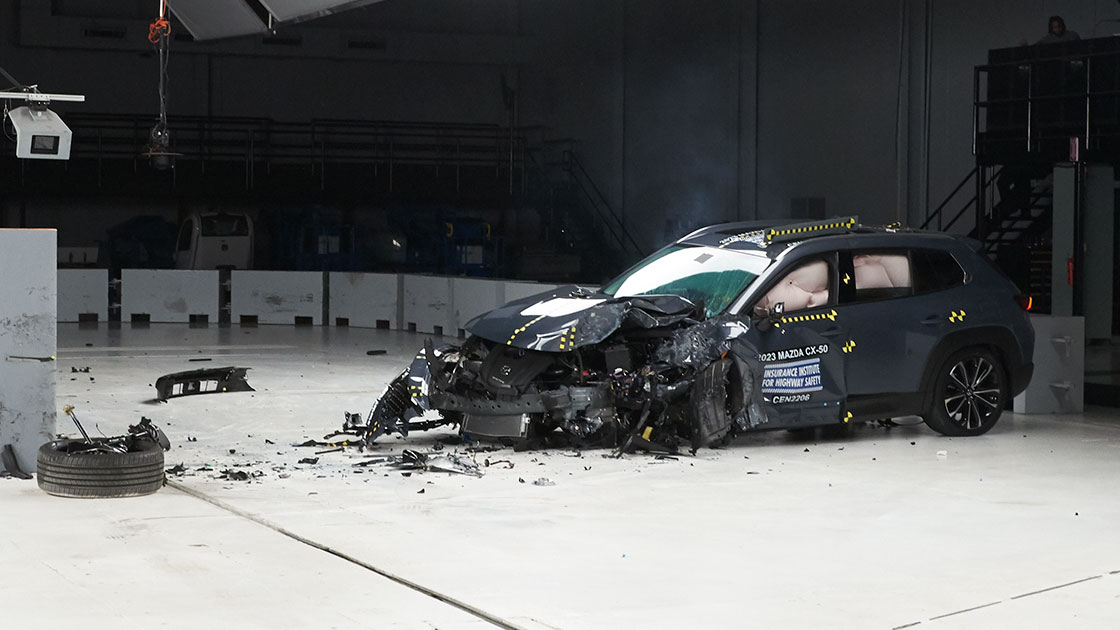Small overlap front crash rating program delivers real-world benefits
March 2, 2023

Driving a vehicle that earns a good rating in the Insurance Institute for Highway Safety’s driver-side small overlap front crash test reduces your risk of dying in a real-world crash, a new IIHS study shows.
A driver in a good-rated vehicle is 12 percent less likely than a driver in a poor-rated one to be killed in a frontal crash, the study found.
“The numbers confirm that strong performance in the Institute’s small overlap front crash test translates into big reductions in fatality risk,” said Eric Teoh, director of statistical services at IIHS and one of the study’s authors.
IIHS added the driver-side small overlap front crash test to its battery of crash evaluations in 2012, targeting fatal crashes that still occurred even though virtually all vehicles were earning good ratings in the long-running moderate overlap test. At that time, an IIHS study indicated that small overlap crashes accounted for about a quarter of the frontal crashes killing or seriously injuring drivers of vehicles with good moderate overlap ratings.
The driver-side and the passenger-side small overlap test introduced subsequently are designed to replicate what happens when the front corner of a vehicle collides with another vehicle or with an object like a tree or utility pole. This type of test is especially challenging because there is often no direct impact with the vehicle’s frame rail and therefore the occupant compartment and other structures must manage the bulk of the energy of the crash.
Teoh examined only the driver-side test in this study because every vehicle involved in a crash has a driver, but the passenger seat is often empty, affecting fatality statistics.
While the moderate overlap test involves 40 percent of the width of the vehicle, in the small overlap tests just 25 percent of the vehicle collides with the barrier. The test vehicle travels at 40 mph toward a rigid barrier. A dummy representing an average-size man is positioned in the driver seat. Ratings are assigned based on the amount of intrusion into the occupant compartment, injury-predicting measurements collected from the dummy and engineers’ evaluation of how well the restraints controlled the dummy’s movement during the crash.
When the small overlap program began, with the driver-side test, only about 10 percent of the vehicles the Institute tested earned a good rating, while 40 percent were rated poor. Today, virtually every vehicle tested earns a good rating in both the driver- and passenger-side tests.
To determine how that progress is affecting crash risk in the real world, researchers used proprietary VIN-decoding software maintained by the IIHS-affiliated Highway Loss Data Institute to identify the make, series and model year of vehicles in which drivers were involved in frontal crashes between 2012 and 2020 and cross-referenced that information with IIHS driver-side small overlap front crash ratings.
The researchers calculated the number of driver deaths per total police-reported frontal crash involvements for each rating and adjusted the results for vehicle type, curb weight and driver demographics. They determined that a driver in a good-rated vehicle is 12 percent less likely to be killed in a frontal crash than a driver in a poor-rated one. An acceptable rating was associated with an 11 percent lower risk of dying, while a marginal rating was associated with a 5 percent lower risk, compared with a poor one.
Notably, federal crash databases do not provide enough information to identify small overlap crashes, so the sample was not limited to the crashes that the test is designed to address. The effect of a good rating is likely much larger among those specific crashes.